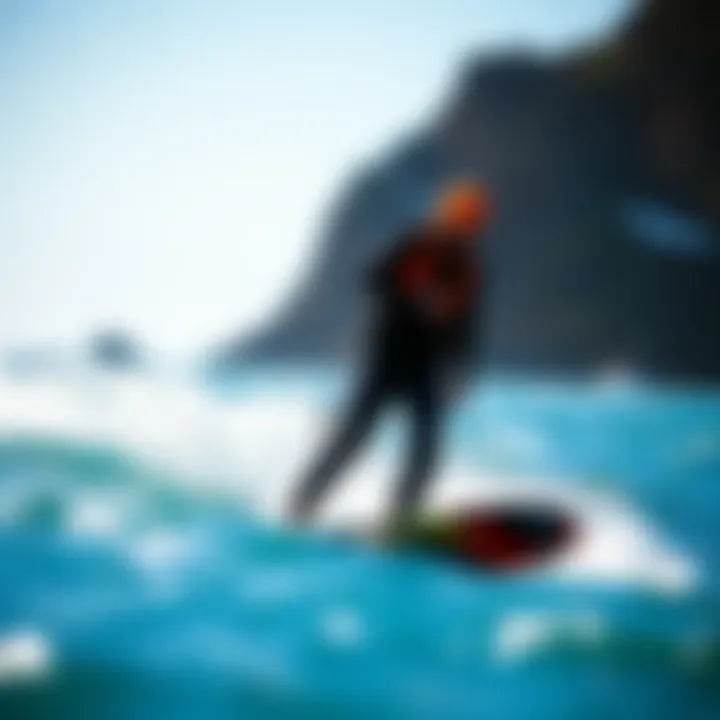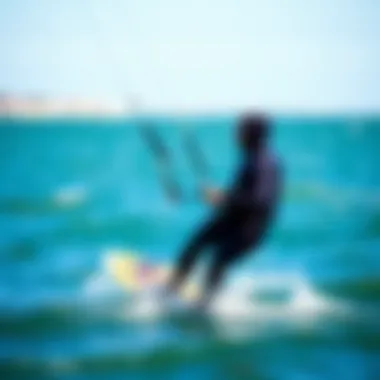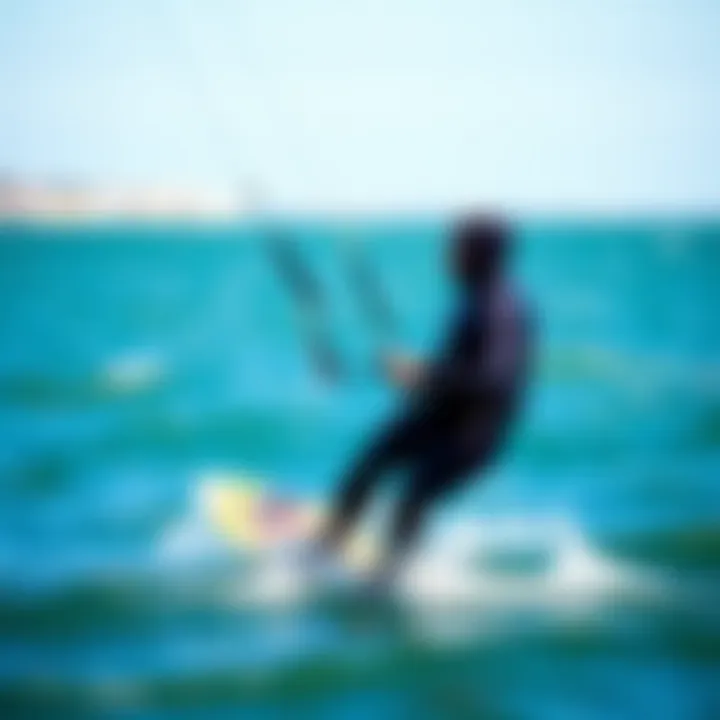Patagonia Neoprene for Kiteboarding: A Complete Guide


Intro
Kiteboarding is a thrilling sport that brings together the elements of wind, water, and skill. In this exhilarating pursuit, the right gear is paramount. Among the critical components of kiteboarding gear is neoprene, particularly Patagonia neoprene. Many kiteboarders, whether just starting or seasoned pros, may not fully grasp the properties that set Patagonia's neoprene apart. This guide aims to unravel the intricacies of Patagonia neoprene while spotlighting its advantages for kiteboarding enthusiasts.
From its production process that emphasizes environmental responsibility to understanding how its performance characteristics enhance your time on the water, we’re diving deep. We’ll also discuss specific products that can amplify both safety and enjoyment during your kiteboarding adventures. Armed with this knowledge, kiteboarders can make informed choices, ensuring they don’t just ride the waves but do so with confidence and style.
Gear Insights
Latest Gear Reviews
When it comes to kiteboarding, having the right neoprene gear can make a world of difference. Here are a few standout Patagonia neoprene products that have gained traction among the kiteboarding community:
- Patagonia R1 Lite Yulex 1.5mm Long-Sleeve Front-Zip Spring Suit: This suit balances warmth and flexibility, making it ideal for both chilly mornings and warmer afternoons. Its natural rubber construction takes a significant step towards sustainability while ensuring comfort.
- Patagonia Vissla 3/2mm Synergy Full Wetsuit: Designed for cooler waters, this wetsuit combines stretch with durability. Its construction highlights Patagonia's commitment to eco-friendly materials, allowing kiteboarders to focus on their performance rather than the impact on the environment.
- Patagonia Worn Wear Recycled Neoprene Vest: Great for layering, this vest provides added warmth without heavy bulk. The recycled neoprene contributes to reduced waste, making it perfect for the eco-conscious adventurer.
These products not only embody Patagonia’s dedication to quality and sustainability but also resonate strongly with the needs of kiteboarders looking for reliability and performance.
Essential Gear for Beginners
For those just dipping their toes into kiteboarding, choosing the right neoprene gear doesn’t have to be a daunting task. Here's a simple breakdown to get started:
- Wetsuit: A basic wetsuit is essential, preferably a thinner option (2-3mm) that still offers flexibility.
- Impact Vest: This provides an extra layer of protection against falls. It’s a must-have, especially for beginners who might be learning new tricks.
- Booties: Think about getting a pair of neoprene booties. They enhance grip and warmth, ideal for those early spring sessions.
- Gloves: Depending on your local conditions, neoprene gloves can make a big difference in maintaining warmth.
Getting these essentials can eliminate some cold discomfort and help newbies focus more on mastering their kiteboarding skills.
"The right gear doesn’t just keep you warm; it can transform your kiteboarding experience from good to unforgettable."
Choosing wisely sets the tone, and with Patagonia neoprene, you’re on the right path.
Techniques and Tips
As you gain confidence on the water, enhancing your skills becomes paramount. Incorporating advanced tricks and ensuring safety practices can elevate your kiteboarding experience significantly. Stay tuned as we dive into some advanced techniques and key safety measures for kiteboarders in the following sections.
Prologue to Neoprene
In the world of kiteboarding, the right gear can make or break your experience on the water. At the heart of many essential pieces of equipment is neoprene, a material celebrated for its unique range of properties that cater specifically to water sports enthusiasts. Understanding neoprene is crucial not only for selecting the best gear but also for appreciating the advancements in technology and sustainability that impact the kiteboarding industry today.
Neoprene is not just about keeping warm while riding the waves; it plays a vital role in performance, flexibility, and comfort. Kiteboarders, whether novice or seasoned, need to be aware of how neoprene affects their gear’s functionality. As the tides of environmental consciousness rise, knowing about the methods of production and the material's ecological footprint has become equally important. This article delves deep into the multifaceted aspects of neoprene used by Patagonia, shedding light on its composition, sustainability efforts, and the myriad benefits it provides to kiteboarders.
Definition and Composition
Neoprene, also known as polychloroprene, is a synthetic rubber created through the polymerization of chloroprene. This compound results in a resilient material that remains flexible even in cold water, making it ideal for wetsuits, booties, and other aquatic gear. The composition typically includes other additives to enhance characteristics like buoyancy and resistance to wear and tear. Patagonia's neoprene is often blended with other eco-conscious materials, contributing to both performance and sustainability.
One key aspect to note is the varying thickness of neoprene that influences insulation. Thicker neoprene offers better thermal insulation, while thinner materials provide greater flexibility. Depending on the conditions, kiteboarders need to select the right thickness for optimal performance. For instance, during early spring sessions when the water is still nippy, a 4/3mm suit could be just the ticket, while summertime wavelengths may only require a lighter 2mm suit.
History of Neoprene
The journey of neoprene began in the 1930s. As the need for waterproof and insulated materials grew, specifically for military applications and diving, neoprene emerged as a promising innovation. Its ability to withstand the elements quickly transitioned it into commercial use, paving the way for a variety of applications, from industrial to personal use.
In the kiteboarding realm, neoprene saw significant popularity in the late 20th century as the sport began to flourish. Pioneering brands like Patagonia recognized the potential of neoprene not only for its performance benefits but also as a canvas to express broader ecological issues. With every board that hit the surf, the conversation around sustainability began to form, establishing a legacy of responsibility and innovation that continues to shape the industry today.
Taking a look at the evolution of neoprene reveals not just the advancements in material science but also a shift in consumer expectations. As kiteboarders increasingly value the dual emphasis on performance and environmental stewardship, manufacturers are compelled to innovate, bringing forth products that don’t just perform but respect our planet.
Patagonia's Commitment to Sustainability
In an era where environmental concerns weigh heavily on the minds of consumers, Patagonia stands out as a beacon of sustainability in the outdoor recreation industry. For kiteboarders, the alignment of performance gear with ecological responsibility is crucial. This commitment to sustainability ensures that enthusiasts can enjoy their passion while being mindful of their impact on the planet. Patagonia's determination doesn't just stop at quality; it extends all the way to how that quality is achieved. Factors such as ethical sourcing, low-impact manufacturing, and ecological awareness are at the forefront of Patagonia's operations, making it a leader in the movement toward sustainable outdoor gear.
Eco-Friendly Practices
At the core of Patagonia's eco-friendly initiatives is a deep understanding of the environmental footprint associated with production. The brand employs various strategies to reduce this impact:
- Sustainable Materials: Patagonia often utilizes recycled materials, such as recycled polyester and nylon, which significantly lower the need for new resources. This practice not only conserves energy but also reduces waste.
- Water Conservation: Patagonia actively seeks to minimize water use throughout its production processes. For instance, by adopting techniques that use less water, the company works to protect precious water resources in manufacturing regions.
- Fair Trade Certification: Through Fair Trade practices, workers receive fair wages and work in safe conditions. Supporting the communities where production occurs is just as important as protecting the resources.
Patagonia's eco-friendly practices serve as a point of pride for kiteboarders, who can feel good knowing their gear is made with respect for the Earth.
"Patagonia believes that every product we make should not only serve the user but also serve the planet." - Patagonia's Mission


Recycling Program
Another cornerstone of Patagonia's sustainability initiatives is its innovative recycling program. This program is designed not only to encourage responsible consumption but also to extend the lifecycle of gear, which is especially beneficial for those investing in technical equipment like kiteboarding gear. Here’s how the program works:
- Worn Wear Program: Customers are invited to trade in their used Patagonia products, which may still have life in them. These items are either repaired, refurbished, or recycled, reducing landfill waste.
- Material Recovery: Through its recycling efforts, Patagonia recovers all kinds of neoprene and other materials. The recovered materials can go on to be reused in new product lines, thus decreasing reliance on virgin materials.
- Consumer Education: Patagonia actively educates its customers about the importance of recycling and the best ways to care for their gear to maximize longevity and reduce the environmental toll.
The recycling program exemplifies Patagonia's commitment to not just producing sustainable gear, but also fostering a culture of conservation among its users, particularly kiteboarders who cherish both their sport and the environment.
Properties of Patagonia Neoprene
The properties of Patagonia neoprene play a crucial role in its functionality and appeal to kiteboarders. Understanding these characteristics helps riders select gear that aligns with their personal needs, as well as the varying conditions they might encounter on the water. From thermal insulation to durability, each aspect of Patagonia neoprene contributes to an enhanced kiteboarding experience, ensuring comfort and performance.
Thermal Insulation
One of the standout features of Patagonia neoprene is its ability to provide excellent thermal insulation. When you’re zipping through frigid waters, you want a material that traps body heat effectively while allowing for a degree of breathability. This balance ensures that kiteboarders stay warm, even if they take an unexpected plunge. The material’s structure is designed to create tiny air pockets, acting like a barrier against cold water and wind.
That said, not all thermal insulation is created equal. Different weights and thicknesses of neoprene offer varying levels of warmth. For instance, a thicker neoprene is perfect for colder climates, keeping you snug longer. Opting for a 4/3mm wetsuit can be ideal for chilly seasons, while thinner options may better suit milder days.
Flexibility and Comfort
Flexibility can make or break your kiteboarding experience. Patagonia neoprene, designed with mobility in mind, allows for a full range of motion. Kiteboarding requires not just stability, but also agility as you twist and turn. What sets Patagonia apart is the incorporation of innovative foam that molds to the body, enhancing comfort without compromising support.
In addition, the suit's pre-bent structure ensures that you don’t feel restrained as you maneuver. If you've ever worn a wetsuit that hugs too tightly, you know it can limit your performance. Patagonia’s designs, however, embrace the contours of your body, allowing you to move freely while ensuring that warmth and protection are never sacrificed.
Durability and Longevity
Durability is paramount when investing in kiteboarding gear. The consistent wear and tear from aquatic environments can quickly age subpar materials. Patagonia neoprene is known for its high resilience, often standing the test of time under various conditions. Reinforced seams and abrasion-resistant outer layers help minimize issues, ensuring that these suits withstand the rigors of kiteboarding.
The care you take with your gear also plays a significant role in its longevity. Proper maintenance, like rinsing after use and storing away from direct sunlight, can prolong the lifespan of Patagonia neoprene. This attention to detail not only enhances performance but also speaks volumes about environmental respect. With a brand committed to sustainability, you know that opting for Patagonia is a choice that considers the planet's well-being too. After all, kiteboarding should be enjoyed responsibly alongside nature.
"When you're out there, you want to feel free and flexible while knowing your gear has your back. Patagonia neoprene makes that possible, marrying comfort with durability."
By grasping the significance of these properties of Patagonia neoprene, kiteboarders can make informed decisions about their gear. The right neoprene not only enhances performance but also maximizes enjoyment on the water.
Kiteboarding Gear Made with Patagonia Neoprene
When it comes to kiteboarding, gear selection can make or break your experience on the water. Patagonia neoprene has made a name for itself, not just through its environmental commitment, but also due to the practical benefits it offers. Choosing the right gear is essential, and understanding how Patagonia integrates neoprene into their products can significantly affect performance, comfort, and overall enjoyment.
Patagonia neoprene is particularly prized for its balance between warmth and flexibility. This combination allows kiteboarders, whether they are racing across waves or cruising along the shoreline, to maintain agility without sacrificing thermal protection. Let's dive into the various types of equipment made with Patagonia neoprene to better equip kiteboarders for their adventures.
Wetsuits and Shorties
Wetsuits are a staple in kiteboarding gear, and Patagonia's line offers a broad spectrum tailored to different water conditions. One of the standout features of Patagonia wetsuits is their thermal efficiency. These suits keep your body warm in cold water, which is critical, as lost body heat can lead to hypothermia.
Moreover, Patagonia wetsuits utilize what they call Yulex, a natural rubber sourced from renewable latex. This not only improves sustainability but also boosts performance. The flexibility offered by these suits allows for maximum range of motion, making every twist and turn seamless. Shorties, on the other hand, provide the perfect solution for warmer water days, combining essential coverage with breathability. These shorter suits still maintain the quality insulation necessary for chilly breezes that often accompany kite sessions.
"Choosing the right wetsuit can turn a frigid day into a fantastic experience. Patagonia's neoprene technology makes it happen."
Accessories: Boots and Gloves
Kiteboarding is a thrilling sport, but it has its share of challenges, especially when it comes to feet and hands exposed to cold water. Patagonia neoprene boots are designed with these challenges in mind. Their boots come with excellent grip and insulation, which means you won’t end up slipping or feeling numb during those chilly encounters with water. They are designed to fit snugly, preventing water from seeping in while still allowing for breathability.
Similarly, gloves made from Patagonia neoprene serve multiple purposes. The thumb and index finger are often reinforced, allowing for a firm grip on the kite’s control bars. Cold wind and water often serve as deterrents to prolonged sessions; thus, wearing these gloves can considerably extend your time on the water, keeping your hands from freezing and uncomfortable.
Impact Vests
Safety doesn’t take a back seat in kiteboarding gear, which is where impact vests come into play. Patagonia's neoprene impact vests are crafted to absorb shocks and protect vital organs. Despite being lightweight, they offer superior impact resistance, which is a crucial feature for kiteboarders who engage in tricks or jump high into the air.
While they are not flotation devices, they provide necessary lowering of impact during unexpected crashes. These vests fit snugly, allowing for unrestricted movement without becoming cumbersome. Additionally, the added thermal benefits of neoprene will help maintain your body temperature when submerged.
In summary, kiteboarding gear made with Patagonia neoprene strikes an essential balance of comfort, performance, and safety. From full wetsuits to boots and impact vests, each piece of equipment is built not just to function but to elevate the kiteboarding experience. This thoughtful construction promotes not only environmental stewardship but also the overall enjoyment of the sport.
Patagonia continues to raise the bar, providing kiteboarders with the tools they need to navigate the water safely while enjoying every minute of their adventure.
Choosing the Right Patagonia Neoprene Gear
Selecting the appropriate Patagonia neoprene gear is pivotal for kiteboarders, whether you're learning the ropes or carving up the waves like a pro. Using the right gear can dictate not just comfort but also overall performance out on the water. When it comes to kitesurfing, the ocean can be a formidable opponent with its varying conditions, and navigating those waters requires a solid understanding of your gear decisions.


Patagonia, known for its commitment to quality and sustainability, offers a range of neoprene options that cater to different needs. Understanding how to choose the right gear involves more than just picking a size or color; it’s about considering environmental aspects, intended use, and local conditions. The right choice can enhance your experience, improve your safety, and make your time on the water far more enjoyable.
Assessing Water Conditions
Before you dive headfirst into the selection process, it’s essential to take stock of the water conditions you are planning to ride in. Different water conditions – be it choppy, flat, or wave-heavy – require different adaptations from your gear. Here’s what you need to keep in mind:
- Choppy Waters: If you're planning to ride in choppy conditions, go for thicker neoprene. It offers better insulation and will keep you warmer, protecting against wind chill. Look for thicker wetsuits or shorties that have extra padding around key areas like the chest and back.
- Flat Water: For flat, warm waters, a thinner neoprene can suffice. A shorty suit may provide just enough coverage without overheating, allowing for more freedom of movement.
- Wave Riding: If you’re going toe-to-toe with larger waves, consider a full suit with enhanced durability. Opt for reinforced seams that can withstand the wear and tear of the surf.
Here’s a quick guide outlining how to align neoprene thickness with water conditions:
- Areas with temperatures above 70°F: 2mm shorties or less.
- Seas between 60°F to 70°F: 3mm full suits or spring suits.
- For colder waters below 60°F: 4mm or 5mm options are recommended.
Understanding Temperature Ratings
Understanding temperature ratings is crucial for evaluating how your Patagonia neoprene gear will perform in various environments. Each piece of gear will have a recommended temperature range, indicating the water temperatures the neoprene is best suited for. Knowing where you're going to be riding can save you from suffering through cold, uncomfortable sessions.
- Look for the Rating: Patagonia gear may include tags or descriptions highlighting temperature ratings. Familiarize yourself with these ratings to ensure you’re making an informed choice.
- Personal Comfort Level: Everyone has their own tolerance for cold; some might shiver in 62°F water while others are fine. Trust your instincts and don’t be afraid to try different thicknesses to see what works best for you.
- Layering Options: If you're dealing with fluctuating temperatures, think about potential layering. Having a rash guard underneath or considering a vest can add flexibility to your thermal insulation while still allowing for movement.
Remember that gear like hoods, boots, and gloves can play a significant role in overall thermal comfort. If it’s chilly, combining a warmer wetsuit with accessories can secure your comfort, ensuring you remain focused on your riding.
"The right gear checks all the boxes – comfort, durability, and performance. Choose wisely and set yourself up for success on the water!"
By taking the time to assess water conditions and understand temperature ratings, you ensure a seamless connection with your environment. Choosing the right Patagonia neoprene gear isn’t just about looking good; it’s about achieving the best performance while respecting the waters you ride in.
Maintenance of Neoprene Gear
Maintaining neoprene gear is critical for kiteboarders, as it directly affects both the lifespan of the equipment and the performance in the water. Neoprene, while robust, can suffer from wear and tear if not cared for properly. Proper maintenance ensures that your gear keeps you warm, flexible, and safe, allowing you to focus on enjoying your time on the water. This section outlines essential practices to keep your Patagonia neoprene gear in top shape.
Cleaning and Drying Techniques
Keeping your neoprene gear clean is essential for preserving its quality and functionality. After a session on the water, rinse your wetsuit or accessories in fresh water to remove salt, sand, and grime. These substances can break down the material over time if left unchecked.
When it comes to washing, avoid using strong detergents or bleach, as they can degrade neoprene, affecting its insulation and flexibility. Instead, opt for gentle soaps specifically designed for wetsuits, which can be found in many outdoor and surf shops. Here’s a simple cleaning routine:
- Rinse your gear immediately after use in cool, fresh water.
- Wash with a mild wetsuit soap in a diluted mix, gently scrubbing any areas with noticeable dirt.
- Rinse thoroughly to ensure all soap residues are removed.
- Hang your gear in a shaded area out of direct sunlight, which can cause fading and damage to the neoprene. Use a wide hanger to avoid distorting the shape.
Drying your gear properly is just as important as cleaning. Avoid wringing it out or using a dryer, as the heat can warp the material. Instead, lay it flat on a clean surface, or drape it over a shower rod or railing, allowing it to air dry naturally.
Storage Recommendations
Proper storage of your Patagonia neoprene gear can significantly extend its life. Here are some guidelines to keep your gear in peak condition when not in use:
- Store in a cool, dry place: Excessive heat or humidity can ruin the elasticity of neoprene, so choose a well-ventilated location.
- Avoid folding: Try to hang your wetsuit instead of folding it. If folding is necessary, keep creases to a minimum. Prolonged folding can create permanent bends that may weaken the material over time.
- Use a padded hanger: A hanger broader than usual prevents stretching and helps maintain the natural shape of your wetsuit. This slight investment can save you a lot of trouble in the long run.
- Keep away from sharp objects: Ensure no items that may puncture or scratch your gear are nearby. Even minor abrasions can lead to significant issues later.
These maintenance tips are not just a chore; they’re an investment in your gear. Taking the time to properly clean and store your neoprene equipment makes sure you’re always set for your next kiteboarding adventure. As the saying goes, "A stitch in time saves nine," and giving your gear a little love goes a long way.
Environmental Impact of Neoprene Production
The importance of examining the environmental impact of neoprene production cannot be overstated, especially for kiteboarders looking to balance performance and sustainability. Neoprene, while durable and effective in various conditions, raises environmental concerns during its production process. Understanding these factors is essential not only for informed purchasing decisions but also for becoming a responsible steward of our waterways and natural resources.
Chemical Concerns
One of the primary concerns regarding neoprene production lies in its dependence on synthetic methods that often involve harmful chemicals. Traditional neoprene is derived from petroleum, leading to significant emissions during extraction and manufacturing.
- Volatile Organic Compounds (VOCs): These compounds can contribute to air pollution, and their release during production poses health risks to workers and nearby communities.
- Toxic Byproducts: The manufacturing process generates waste, some of which contains hazardous substances that can contaminate local water supplies.
- Greenhouse Gas Emissions: The energy-intensive nature of neoprene production means that it also plays a role in climate change, as it often relies on fossil fuels.
Patagonia strives to mitigate these chemical concerns by exploring eco-friendlier manufacturing options, emphasizing the importance of transparency in their processes. The company seeks to minimize its carbon footprint while not compromising on the quality of products kiteboarders rely on.
"In the quest for sustainability, we need not only to consider what we create, but also what we leave behind."
Comparative Analysis of Alternatives
With the growing awareness of neoprene’s environmental implications, many kiteboarders are looking toward alternatives. A comparative analysis reveals several biodegradable and more sustainable materials:
- Yulex: Made from natural rubber and sourced from a sustainable plantation, Yulex offers a viable alternative to traditional neoprene. Its performance characteristics are comparable, providing warmth and flexibility while reducing carbon emissions.
- Recycled Materials: Some companies have begun using recycled plastics and rubber to create kiteboarding gear. By utilizing existing materials, they minimize waste and lessen the demand for new resources.
- Organic Cotton and Hemp: For some accessories, the use of organic cotton and hemp can offer an eco-friendly choice. These materials are biodegradable and less polluting during their life cycle.


When assessing alternatives, kiteboarders need to evaluate the material's performance, durability, and comfort. Finding a balance between environmental responsibility and the level of performance expected in different water conditions is key.
Ultimately, the push for more sustainable practices is not just about replacing products; it's about reshaping the industry norms. By supporting brands that prioritize eco-friendly options, kiteboarders can actively contribute to reducing the environmental impact associated with their gear.
Innovations in Neoprene Technology
Innovation in neoprene technology plays a crucial role in the evolution of kiteboarding gear. As the sport continues to grow, so too does the demand for products that are not only performance-oriented but also sustainable. The advancement of neoprene, particularly in its environmental impact and functional features, helps kiteboarders enjoy their sport while being more conscious of the materials they choose.
Bio-based Neoprene
Bio-based neoprene represents a shift in how industries think about material sourcing. Unlike traditional neoprene, which is derived mainly from petroleum, bio-based neoprene incorporates renewable resources. These resources often include plant-based materials, which reduces dependency on fossil fuels and helps lower greenhouse gas emissions associated with production.
For kiteboarders, using gear made from bio-based neoprene has several advantages:
- Comfort and Flexibility: Bio-based neoprene maintains similar comfort and flexibility levels compared to its petroleum-based counterparts. This ensures that kiteboarders can still perform at their best without sacrificing comfort.
- Environmental Responsibility: Choosing gear that utilizes bio-based neoprene promotes a sense of environmental stewardship among kiteboarders. As they navigate the waves, they can feel good knowing their gear is contributing to a more sustainable future.
- Performance: Many brands, including Patagonia, have invested in research to enhance the performance of bio-based neoprene. They strive to ensure that these new materials meet or exceed the expectations of serious kiteboarders.
Overall, the adoption of bio-based neoprene not only marks a significant technological advancement but also aligns with the values of many kiteboarding enthusiasts who care about the planet.
Enhanced Performance Features
As kiteboarding technology advances, the quest for better performance becomes paramount for both recreational and professional kiteboarders. Innovations in neoprene are no exception. This section examines some of the enhanced performance features designed to improve the overall kiteboarding experience.
One notable example is the incorporation of thermal regulation systems in neoprene gear. This feature aims to maintain a comfortable body temperature in varying water conditions. Such temperature management allows riders to endure longer sessions without feeling the bite of cold water.
Additionally, manufacturers are focusing on:
- Improved Stretches: New blends of neoprene exhibit greater stretchability without compromising strength, allowing kiteboarders to maximize movement while staying agile.
- Seam Technology: Innovative seam construction methods enhance durability while preventing water from seeping through. Proper sealing maintains the integrity of the gear, keeping kiteboarders dry and warm.
- Lightweight Materials: Advances in material science have led to lighter forms of neoprene that do not sacrifice protection. This transformation allows for more dynamic performance without the bulk that often hinders movement.
With innovations in neoprene technology, kiteboarders can now find gear that combines durability, flexibility, and sustainability, ultimately leading to an enhanced experience on the water.
In summary, the advancements in neoprene technology are not just about improving the material's core attributes; they also aim to create a product that caters to the needs of kiteboarders. This balance of performance and eco-consciousness ensures that as the sport grows, it does so with an eye toward preserving the environment.
User Experiences and Testimonials
User experiences can significantly enrich the understanding of Patagonia neoprene gear, providing insights that go beyond technical specifications and marketing jargon. The real-life reactions and anecdotes from kiteboarders reflect genuine interactions with the products, shedding light on durability, comfort, and performance in diverse conditions. For both novices and seasoned enthusiasts, these testimonials serve as a compass for choosing the right gear, helping to make informed decisions that can enhance safety and enjoyment on the water.
Feedback from Kiteboarding Community
The kiteboarding community thrives on shared experiences, and feedback regarding Patagonia neoprene is no exception. Many riders emphasize how Patagonia gear excels in thermal insulation, allowing longer sessions without the nagging chill. For instance, one kiteboarder shared that wearing a Patagonia wetsuit during a windy day with water temperatures dipping below 60 degrees allowed them to enjoy hours of riding without discomfort. District Oldman, an avid kiteboarding instructor, remarked, *"I can tell my students when they wear Patagonia, they feel less wearied after a session. It’s like their energy is conserved instead of fighting off the cold."
Additionally, several experienced riders noted the flexibility of the neoprene, stating that it provides a range of motion that is often missed in other brands. As Nicole, a multi-year kiteboarding competitor, expressed, her Patagonia shorty "allows for seamless twists and turns; it feels like a second skin."
Online platforms such as Reddit and Facebook groups, where kiteboarding lovers congregate, are brimming with discussions on Patagonia. Users often exchange tips on which gear performs best under different conditions, reinforcing community ties and encouraging new kiteboarders to opt for trusted products.
Case Studies of Gear Performance
Diving into specific case studies can provide clarity on how Patagonia neoprene stands up to the rigors of kiteboarding. For instance, numerous riders have documented their experiences with Patagonia’s performance-oriented wetsuits during critical tournaments.
In one such instance, a team of professional kiteboarders participated in an annual international competition in Brazil. They collectively decided to equip themselves with Patagonia suits based on prior testimonies of reliability under pressure. Result? The gear not only kept them warm through gusty winds but also held up beautifully against the wear and tear of high-performance jumps and flips.
Another fascinating case involved a group participating in a challenge along the coastline of New Zealand. The waters were notoriously fierce, yet one rider, equipped with a Patagonia impact vest, successfully tackled waves that left many competitors in trouble. Their account emphasized the balance between buoyancy and freedom of movement, which the vest provided, allowing them to navigate perilous waters confidently.
These case studies highlight that Patagonia neoprene gear isn't just about personal preference; it becomes a lifeline in challenging conditions, fostering not only a sense of safety but also unlocking the full potential of kiteboarding adventures.
"Real stories highlight not just the brands, but the bond between you and the water. It’s about what gear does for you in those moments out there." - Anonymous kiteboarder.
Ending
As we draw to a close on this exploration of Patagonia neoprene, it is crucial to acknowledge its significance in kiteboarding. This material isn't just about keeping warm; it embodies a blend of technology, environmental consciousness, and user experience that dictates the quality of time spent on the water.
Summarizing the Key Points
At the heart of our discussion lies three pivotal aspects of Patagonia neoprene:
- Sustainability: Patagonia's commitment to eco-friendly practices is commendable. They work to reduce the environmental footprints of neoprene production, ensuring materials used are not only efficient but also respectful of the planet.
- Performance: Whether it's the thermal insulation that keeps the cold at bay, the flexibility that allows for maximum maneuverability, or the durability that means your gear will last season after season, Patagonia neoprene proves its worth on various fronts.
- User Experience: Testimonials from kiteboarders depict a clear preference for Patagonia's gear, emphasizing comfort and reliability. Kiteboarding, at its core, is about enjoyment and freedom, and having the right gear directly influences that experience.
Future Trends in Neoprene Gear
While we can appreciate what Patagonia neoprene offers today, it's also exciting to look ahead. The evolution of materials will likely be driven by a few key factors:
- Innovative Materials: A growing interest in bio-based alternatives is prompting manufacturers to look beyond traditional neoprene. Expect to see more products constructed with sustainable resources without compromising performance.
- Enhanced Customization: Future trends may include gear that offers personalized fits or features adapted to individual riding styles. As technology in production continues to advance, tailored solutions could be on the horizon.
- Smart Technology: The integration of technology into kiteboarding gear can’t be overlooked. Imagine wetsuits that provide real-time analytics on body temperature, hydration levels, and even performance metrics!
In summary, the journey of Patagonia neoprene is captivating, pointing towards a future where performance and sustainability go hand in hand. For kiteboarders—both seasoned and those just dipping their toes—the blend of knowledge and evolving trends in gear can only enhance the experience on the water.















